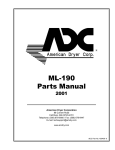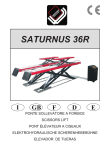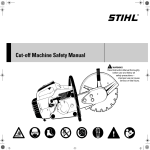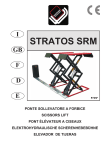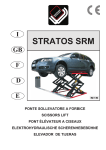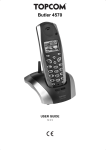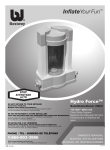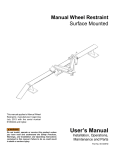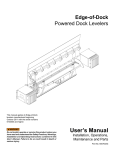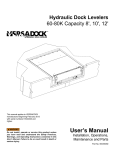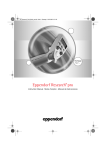Download Pentair filter User's Manual
Transcript
PENTAIR POOL PRODUCTS THS SERIES FILTER OWNER’S/OPERATOR’S MANUAL TANKS ONLY This manual covers the following filter tanks: THS3461 THS3484 THS4272 THS4284 THS4296 WARNING: This manual contains critical safety information that must be furnished to the end user. Failure to read and follow the instructions could result in serious personal injury and/or major property damage. Pentair Pool Products 1620 Hawkins Ave. Sanford, NC 27330 Phone: 919-774-4151 Fax: 919-774-4841 TABLE OF CONTENTS 1.0 Basic Principles of Operation 1.1 Filtration - How Your Filter Works 1.2 Backwash 3 3 4 2.0 Installation and Assembly 2.1 Receiving and Inspecting 2.2 Locating the Filter 2.3 Setting Anchor Bolts 2.4 Install All Piping 2.5 Inspection of Components 2.6 Pressure Test System 2.7 Media Installation 5 5 5 6 7 7 8 9 3.0 Start-up and Operation 3.1 Backwash System 3.2 Return Filters to Normal Filtration Mode 9 9 9 4.0 Maintenance 4.1 Periodic Backwash 4.2 Periodic Inspection of filters 4.2 Draining the Filters 4.3 Installation/Removal of Manway Cover 4.4 Removal of Sand Media 4.5 Winterizing the filter tanks APPENDIX APPENDIX A: APPENDIX B: APPENDIX C: APPENDIX D: APPENDIX E: APPENDIX F: Tank Owner’s Manual 9/26/05 10 10 11 12 13 13 14 Pressure Drop Curves Media Requirements Troubleshooting Backwash Log Tank Specifications Tank Parts Pg. 2 of 23 Rev. D Thank you for purchasing your new high rate sand filter from Paragon Aquatics. Your new filter vessel is the best that money can buy, with its ability to operate for years with a minimum amount of maintenance, as well as having excellent resistance to corrosion due to its all fiberglass construction. In this manual you will learn the basic principles on how your new filter operates, as well as how to install, operate, and maintain it. We suggest reading this manual through once to familiarize yourself with it before proceeding with installation and operation. Again, thank you for purchasing your high rate sand filter from Paragon Aquatics. 1.0 Basic Principles of Operation Your high rate sand filter is designed to operate for years with a minimum amount of maintenance when installed, operated and maintained in accordance with these instructions. 1.1 Filtration - How Your Filter Works The basic principals of filter operation are as follows: Dirty water enters the filter tank by being pumped under pressure through the influent pipe and is distributed across the top of the inner tank chamber through diffusers. The water is then forced downward through the sand filter bed. Dirt and debris is collected in the sand bed allowing clean water to pass through. The clean water then passes through the collection laterals and exits the filter through the effluent piping and is returned to the pool. Tank Cross Section During Normal Filtration Tank Owner’s Manual 9/26/05 Pg. 3 of 23 Rev. D The pressure in the filter will increase and the flow of water through the filter will diminish as dirt accumulates in the filter. Eventually, the filter will become obstructed enough with dirt that it will become necessary to backwash the filter. Please note that a filter removes suspended matter but it does not sanitize the pool. The pool water must be sanitized and the water must be chemically balanced for optimum water clarity. Your filtration system should be designed to meet your local health codes. Pool chemistry is a specialized area and you should consult your local pool service specialist for specific details. 1.2 Backwash The basic principal of filter backwash is to reverse the flow of water through the filter. This will remove the dirt and debris trapped in the filter bed. For this principal to work properly a flow of 15-20 GPM per square foot of filter area should pass through the filter in the reverse direction. This will help to fluidize the sand bed, loosening any solids trapped or compacted in the bed, and then lifting the solids and transporting them out of the filter to waste. Usually a two to five minute backwash duration is all that is necessary to clean the filter. Please note, it is absolutely necessary to have a large enough waste line to accommodate the backwash flow rate of the filter. A 6” waste line is recommended for all THS series filter vessels. Tank Cross Section During Backwash Mode Tank Owner’s Manual 9/26/05 Pg. 4 of 23 Rev. D 2.0 Installation and Assembly If you have purchased the vessel(s) with the optional face piping kit, please refer to documentation provided with the face piping kit. 2.1 Receiving and Inspecting • Upon receipt of filter(s), check the filter pallet(s) and auxiliary cartons for any evidence of damage due to rough handling in shipment. If the filter(s) or any filter components are damaged, NOTIFY FREIGHT CARRIER IMMEDIATELY. • Verify that you have all equipment contained on the Packing List(s) and that there is no apparent damage to this equipment. NOTE: BEFORE BEGINNING INSTALLATION, MAKE SURE PROPER SAFETY EQUIPMENT IS BEING USED. 2.2 Locating the Filter • Prior to installing the filter(s), be sure to provide a PERMANENT LEVEL SLAB on which to mount the filter. Preferably the slab should consist of reinforced concrete poured in a form. Alternately, the filter(s) can be mounted on a platform constructed of concrete block or brick. The platform must be able to support the weight of the entire system (including media and water). DO NOT use sand to level the filter(s) or for pump mounting, as it will wash away. • Position the concrete slab so that the instructions, warnings and the pressure gauges on the system will be visible to the operator. It should be positioned so that the piping connections, manway, and drain are convenient and accessible for servicing and winterizing. If possible, ensure that the filter(s) are positioned to accommodate any rough plumbing that may have been previously installed. Dimensions ‘A’ and ‘B’ in Figure 1 (next page) give the minimum filter to wall clearance in order to maintain a 6” minimum clearance between the tank and the wall (or other equipment). These are only given as minimum distance guidelines. Tanks may be set up at larger clearances if desired. IMPORTANT: If a pre-glued diaphragm valve face piping kit has been purchased, it is very important that the center to center (“C-C”) of the tanks be held to the dimension listed in Figure 1. Failure to do so may cause the piping kit not to fit properly. Tank Owner’s Manual 9/26/05 Pg. 5 of 23 Rev. D Figure 1 Model "A" (in.) "B" (in.) "C-C" (in.) THS3461 39 THS3484 THS4272 THS4284 6 6 46 1/4 THS4296 • Ensure that the tank(s) are level, both across each pipe connection and from the influent pipe to the effluent pipe. For two tank systems, make sure the tanks are level to each other. If adjustments need to be made, loosen the nut underneath the saddles and adjust the saddle placement as needed. Be sure to tighten the nut after adjustment. If shimming is required to raise one end of the tank, be sure to use a non-compressible material placed under the bottom of the tank saddle. 2.3 Setting Anchor Bolts NOTE: Local, county, and state codes may require that the tanks be anchored in a specific way. Please verify before proceeding with anchor installation. • If the tanks are to be anchored to the slab, mark the holes when the tanks are in their desired position on the slab. Install anchors per manufacturer’s specifications. NOTE: Move the tanks aside before drilling for anchors. This may be necessary in order to comply with the anchor manufacturer’s instructions, and will avoid damage to the tanks and/or saddles during anchor installation. Tank Owner’s Manual 9/26/05 Pg. 6 of 23 Rev. D 2.4 Install All Piping NOTE: Unless the optional piping kit was purchased from the filter manufacturer, which provides the valves and piping to facilitate proper backwash and filtration operation, the filter manufacturer cannot accept responsibility for the design, installation, and operation of same. If an optional face piping kit was purchased, please refer to the appropriate manual provided with the kit for installation instructions. • Install all piping to provide proper filtration and backwash operation. We recommend dry fitting all piping to ensure the proper fit. • The influent/effluent piping on the tanks are supplied with grooves for grooved coupling connections. If a flanged connection is desired, a flange can be solvent welded to the pipe on the tank. Use a PVC cement which has been NSF approved for potable water applications. Apply according to manufacturer’s instructions. Please note, certain modifications to the tank may void the manufacturer’s warranty. Please contact manufacturer before proceeding with any modifications. • Once installed, all piping must be fully supported with bracing and hangers (by others) to prevent damage to the system from weight and vibration. 2.5 Inspection of Components Before performing the initial start up of the filter system, inspect the tanks and components to ensure that no damage has occurred during the shipment of the vessel. • Check for loose, damaged, and missing laterals. If they are loose, tighten them to hand tight, making sure that the slots are facing down. Missing or damaged laterals can result in returning the sand media from the filters to the pool, and must be replaced. Lateral • Check for loose, damaged, and missing diffusers. These are a key component in flow distribution in the tank. If they are loose, tighten them to hand tight. Missing or damaged diffusers should be replaced. Diffuser Tank Owner’s Manual 9/26/05 Pg. 7 of 23 Rev. D • Check effluent piping grooved coupling connection to make sure it has not become loose during shipping. If the coupling bolts have become loose, tighten them. • Make sure automatic air relief is attached properly. This mechanism assists in bleeding off air, which may become trapped in the top of the tank. It is located on the effluent pipe near the top of the tank, and should be installed with the screen pointing up. 2.6 Pressure Test System Automatic Air Relief Assembly WARNING: Filters should never be tested or subjected to air or gas under pressure. All gases are compressible, and under pressure create a danger. Severe bodily injury or property damage could occur if the filter is subjected to air or gas pressure. CAUTION: DO NOT exceed the maximum working pressure of the vessel (50 psi) during testing or operation. NOTE: DO NOT install media prior to pressure testing the system. • Install the manway cover (See section 4.3) and check that all piping connections, manual air relief cap, and media drain cap are tight. • Flood the system with water. Make sure to bleed all air out of the tanks using the manual air relief cap. • Pressurize the system. Caution: DO NOT exceed 50 psi. • Inspect all installed filtration equipment, focusing on solvent welded connections, mechanical connections, and all tank penetrations. NOTE: In the unlikely event that a leak is attributed to the vessel, consult the equipment supplier before proceeding with any tank repairs. Unauthorized repair attempts may void the factory warranty. • Drain the tank(s). It is important to read section (4.2) for proper instructions. • Make repairs if necessary. Before proceeding further, all repairs should be made at this time. NOTE: Do not perform the following step until the system is pressure tested and all leaks are repaired (See Start-Up and Installation). Tank Owner’s Manual 9/26/05 Pg. 8 of 23 Rev. D 2.7 Media Installation • Consult Appendix B for media specifications. • Partially fill the tank with water. This will help prevent damage to the internal piping when installing the gravel. • Install the gravel media. This layer should reach to the top of the effluent laterals and be level. • Install the sand media. This layer should reach to approximately the centerline of the tank. The sand bed should be level and smooth. See pictures at right for example. 3.0 Start-up and Operation Above: Sandbed should be flat and smooth when sand is installed. The following steps should be followed in the order shown for initial start up of the filter system. Each section will be explained in more detail in the following pages. 1. Start system in backwash mode 2. Backwash each tank until clean 3. Start system in normal filtration mode 3.1 Backwash System After the media is in place, reinstall the manway cover and fill the system with water. It is again important that all air in the tank(s) be bled out using the manual air relief fitting on the top of the tank(s). Once all of the air in the tanks is released, you may begin the initial backwash of the tanks. Each tank should be backwashed for at least 5 minutes to remove any dust or dirt from construction, as well as the “fines” in the media. When the wastewater coming from the backwashed tank runs clear and is free of grit, the tank has been fully backwashed. Repeat this for all tanks in the system. For some instances it may be necessary to repeat this backwash procedure a second time in order to ensure that all “fines” have been removed. Some things that should be noted during the backwash cycle: • • Adequate backwash flow (Approx. 15-20 GPM per square foot of filtration area) Quality of water flowing to waste (i.e. dirt, grit, etc.) During a backwash the pressure through the system may differ from when it is in filtration mode. This is normal, however it is important to make sure that the pressure does not exceed the operating pressure of the tank. 3.2 Return Filters to Normal Filtration Mode After backwashing is complete, run the system in normal filtration mode. Once this is done, you should take note of the following: • Inspect pool water returns for sand. If the filter is returning sand to the pool, turn off the system immediately. Refer to the Appendix C for further information. Tank Owner’s Manual 9/26/05 Pg. 9 of 23 Rev. D • Verify pressure differential through the vessels is within an acceptable range. Refer to Appendix A for pressure drops through the tanks only. Please be aware that depending on where the pressure readings are taken from and the design of piping system, the pressure drops through the system will be greater than what is shown in Appendix A. Please consult the water circulation system designer for more details. • Note the pressure differential over the now clean filter system. If the system is filtering within an acceptable pressure loss range, with the maximum pressure not to exceed 50 psi, then the filter(s) can be considered clean. Please note the differential pressure, as it may be needed later to determine backwash schedules. See section 4.1 for more details. Appendix D, which will be referred to later, provides a chart to log these pressures into for future reference. Congratulations, your filter is now ready to filter water. Please read the next section on Maintenance to learn how to care for your new filter tank(s). 4.0 Maintenance Although the “Smoothie” filter vessel is designed to operate for many years with little maintenance, there are some items that should be periodically inspected. In certain situations, periodic maintenance may be necessary. The following is a list of items that should be checked periodically, as well as some maintenance items, which may need to be performed. IMPORTANT: When performing maintenance, which requires entry into the tank, VERIFY that all water sources to the tank are isolated and locked and tagged out before entering tank. This is a confined space situation and all rules and safety guidelines set forth by OSHA regarding such situations should be strictly followed. 4.1 Periodic Backwash If you have purchased the vessel(s) with the optional face piping kit, please refer to documentation provided with the face piping kit. The tanks need to be backwashed when the sand bed becomes clogged with debris from the pool. There are a few different ways to determine when backwashing should occur. The following are the most common methods, however depending on piping design; backwash frequency can be determined in a different manor if desired. • Pressure Differential. When tanks become dirty, the pressure through them increases. During the initial pressure test of your tank(s), the pressure through the clean filter(s) should have been noted and recorded. This is your clean filter pressure differential. When the filter pressure increases by 10 psi above this clean filter pressure, the tank(s) should be backwashed. • Time Schedule. If desired, the system can be backwashed based on a time schedule, such as once a week. This is up to the user as to when to backwash the tank(s), however it is recommended that backwashing occur often enough so the tanks don’t become too clogged. This may be especially necessary after periods of increased bather load. Tank Owner’s Manual 9/26/05 Pg. 10 of 23 Rev. D When backwashing, it is important that there is: • Sufficient Backwash Time. It is recommended to backwash each tank for at least 5 minutes • Sufficient Backwash Flow Rate. The flow going through the tank in backwash mode must be in the range of 15 to 20 GPM/ft2 in order to accomplish an adequate backwash. NOTE: It may be necessary in some instances to backwash the tanks more than once to achieve a clean sand bed. It is recommended that the influent and effluent pressures be recorded at the time of each backwash. Appendix D has been provided to record these pressures. This information may be useful in determining backwash frequency. It may also be useful in troubleshooting some types of problems. 4.2 Periodic Inspection of filters Part of the maintenance schedule that is suggested for these tanks is to check certain areas of the filter tanks for signs of possible problems. Below are some key areas, which should be inspected regularly. • Inspect Media Bed. The sand media bed should be inspected on a yearly basis, or whenever the system is drained for maintenance. The sand bed should be smooth and level. A difference in sand elevation between the highest and lowest points of the bed that is 3” or more may indicate a problem which may require further investigation. This may indicate that there may be damaged internal tank components such as diffusers or laterals. Above: Typical sand beds after draining tanks. Note the smooth, flat sand bed. There are no signs of trenching or erosion. Below: The sand beds shown below may indicate a problem. Note the trenches and erosion of the media, which has developed. Tank Owner’s Manual 9/26/05 Pg. 11 of 23 Rev. D • Inspect tanks for leaks. The system should be inspected periodically for leaking around the influent/effluent piping penetrations, drain port, manual air relief fitting, and on the outside shell of the tanks. A quick visual sight inspection is all that is needed to accomplish this. In the unlikely event that a leak is attributed to the vessel, consult the equipment supplier before proceeding with any tank repairs. Unauthorized repair attempts may void the factory warranty. • Take note of system parameters (Influent/Effluent pressure). This is especially important if you are not using an automatic backwash control system. These parameters are prime indicators as to whether or not a backwash cycle needs to be run. They should be checked every couple of days, particularly after periods of increased bather load. 4.2 Draining the Filters Some maintenance may require the filters to be drained of all water. To accomplish this you must: • Make sure that the system is shut down. Isolate all water sources from the filter(s). • Remove the drain cap located on the bottom of the front of the tank. See figure below for location. • Open the manual air relief on top of the tank. This will allow the water to drain faster as well as to prevent the creation of a vacuum in the tank. NOTE: A vacuum condition in the tanks can damage the tanks and possibly other components in the filter system. Figure 2 • Replace Caps when water is drained. Tank Owner’s Manual 9/26/05 Pg. 12 of 23 Rev. D 4.3 Installation/Removal of Manway Cover NOTE: It is important that the manway yokes never be removed during operation of the tanks. The tanks should be drained before removing manway cover. 4.3.1 4.3.2 Removal: • • Drain the tanks. See section 4.2 for instructions. Remove one yoke bolt and yoke. This will require a 1 1/8” wrench. Loosen the second bolt, but do not remove the second yoke. • Remove cover from tank. Rotate remaining yoke90° and push cover into tank. Turn the cover so that it will pass through the manway opening and remove the cover. Make sure the manway gasket is with the cover. If not, look for it on the manway opening or inside the tank. Installation: *Manway cover may differ from picture below Gasket ring • Ensure there are no tools, construction materials, or foreign objects in the tank. • Clean the sealing surfaces of the cover and manway opening. Make sure they are free of dirt and debris. • Install gasket ring on manway cover. See picture at right for correct location. • Maneuver the cover back into the tank so it fits back in the manway opening. Follow removal directions in reverse order. • Install yokes, bolts, and washers. Make sure the yokes are in the proper locations. See picture at right. Correct yoke orientation • Snug yoke bolts. Tighten bolts one full turn past hand tight. If manway leaks during refilling of system, tighten bolts in quarter turn increments until leak stops. After filter is at operating pressure, yokes will be loose due to internal pressure. Snug bolts until yokes no longer move. DO NOT exceed 15 ft/lbs of torque. 4.4 Removal of Sand Media The sand media in the filter should be removed when: • Media bed has become contaminated. The media bed can become contaminated due to the introduction of an unwanted substance into the water, such as fecal matter, chemicals, etc. While the filters will take out the particulate matter of the contaminate and prevent it from returning to the body of water, the contaminate will become embedded in the media. This can affect pool chemistry. Tank Owner’s Manual 9/26/05 Pg. 13 of 23 Rev. D • Filters need to be moved from their current location. While these tanks are designed to withstand internal pressure, they are not designed to be transported with the added weight of the media inside of them. It is therefore necessary to remove as much media as possible before relocating the filters. • Inspections/repairs need to be made to inside of tank or internal components. In order to reach certain components or areas of the tank, the sand has to be partially or removed. These areas include laterals, effluent piping, media drain assembly, inside walls of the filter. If you need to remove the media the tanks must be drained first, see Draining Filters section. After draining the filters, remove the manway cover (see Section 4.3.1). Removal can be done by a variety of means, from using an ordinary shovel, to adding water to the sand and removing the slurry with a pump truck. It is important that if using shovels or other devices with edges, corners, etc. that care be taken to not scratch the inside walls of the tank. The inside walls are coated with a material that protects the water from exposure to the fiberglass walls of the tanks. Remove only as much material as required to perform any maintenance operations. If all of the sand needs to be removed for the purpose of replacement due to contamination, be sure to rinse out the tank with clean water. It may be necessary to backwash the tank(s) after rinsing to remove sand stuck in the laterals. Follow the backwash procedures outlined earlier in this section. 4.5 Winterizing the filter tanks In areas where the tanks will not be in service during the winter months, or where tanks may see freezing or below freezing temperatures, it is recommended that the tank(s) be winterized. This will protect the tank(s) from being damaged due to ice expansion. Some items that may be damaged due to this may include internal piping, internal components, and tank walls. Below are the steps that should be performed when winterizing the tank(s): • Thoroughly backwash each filter to remove foreign contaminates from the filter bed prior to draining the system • Shut off all electrical power to the filter system. • Drain the tanks by removing the drain plug from the tank (See Section 4.2). Opening the manual air relief valve cap will help in allowing the water to drain out of the filters, as well as preventing a vacuum condition from occurring. • When the water is drained from the system, drain all of the water in the backwash line. • Loosen any flanges in low-lying sections of piping to completely drain the system of water. • Store any plugs/caps removed near the filter and mark all flanges that have been loosened so that they may be reinstalled and tightened at time of start up. Tank Owner’s Manual 9/26/05 Pg. 14 of 23 Rev. D APPENDIX APPENDIX A PRESSURE DIFFERENTIAL CURVES APPENDIX B MEDIA REQUIREMENTS APPENDIX C TROUBLE SHOOTING APPENDIX D BACKWASH LOG APPENDIX E GENERAL TANK SPECIFICATIONS APPENDIX F TANK PARTS Tank Owner’s Manual 9/26/05 Pg. 15 of 23 Rev. D APPENDIX A Clean Filter Pressure Drop 3.5 3 psi 2.5 2 THS 34xx 1.5 THS 42xx 1 0.5 0 0 5 10 15 20 25 GPM/sq.ft Clean Filter Pressure Drops 2.5 2 THS 4296 THS 4284 psi 1.5 THS 4272 1 THS 3484 THS 3461 0.5 0 0 200 400 600 GPM NOTE: 1. The charts are based on using NSF approved #20 sand in the filters. Variation in sand media may affect pressure differential values. 2. These charts are for pressure drop through the tanks only. Depending on the location of the pressure gauges, there will likely be additional contributors to the pressure differential, such as valves, fittings, etc. Tank Owner’s Manual 9/26/05 Pg. 16 of 23 Rev. D APPENDIX B Filter Model Filter Area 2 (Ft ) Total Media Requirement 3 (Ft ) Sand Media 3 (Ft ) Gravel Media 3 (Ft ) (Optional) THS3461 13.5 16.6 (1660 lbs.) 11.1 (1110 lbs.) 5.5 (550 lbs.) THS3484 THS4272 23.5 19.0 (2350 lbs.) 29.1 19.7 (2910 lbs.) 34.6 14.4 (1440 lbs.) 22.1 (2210 lbs.) 26.7 (3990 lbs.) Media Type Media Size Specific Gravity Uniformity Coeffictient Pea Gravel 1/4" - 1/8" Greater than 2.5 Less than 1.5 Sand #20 Standard .018"-.022" (.45mm-.55mm) 2.65 Less than 1.5 39.9 11 8 5/16 (700 lbs.) 7.5 (860 lbs.) THS4296 7 1/2 7.0 31.3 (3130 lbs.) (3460 lbs.) Gravel Depth (in.) (910 lbs.) (750 lbs.) 23.2 Sand Bed Depth (in.) 9.1 27.1 (2710 lbs) THS4284 Freeboard Height (in.) 8 1/2 16 8.6 NOTE: 1. All gravel and sand should be washed and screened. It should contain less than 1% of loam, clay, sand, shells, dirt organic impurities or other foreign matter. 2. It is recommended that all media used be NSF approved. Tank Owner’s Manual 9/26/05 Pg. 17 of 23 Rev. D 7 1/2 APPENDIX C Problem Possible Cause Solution Maintain pool chemistry. Consult pool service technician 1. Water chemistry not in balance Verify media size with media vendor. Consult Appendix B of this manual for proper media sizing. If the media is the incorrect size, replace with proper media. 2. Incorrect media installed 3. Filter sytem not being backwashed properly Source water not sufficiently clear The tank(s) may not have been backwashed enough upon initial start-up. Repeat the backwash procedure for initial start-up (see Start-up and Operation section). Backwash each tank twice to ensure that the media bed is clean and free of debris. Adjust the flowrate throught the filters. These filters are designed to operate at a 2 2 4. Rate of flow in excess of 20 GPM/ft of filter area maximum of 20 GPM/ft . If flow rates are in excess of this, the media bed will not perform as designed. 5. Inadequate turnover rate The turnover rate is the amount of time it takes the filters to pass the entire volume of the pool through the filter system. Filtration systems for pools are typically designed to operate at a turnover rate of 1-6 hours typically depending on the application and appropriate codes. If the filter system is filtering the water too slow, dirt and debris can build up faster than the water is cleaned. The flow through the filters may need to be increased. Consult the manufacturer before changing the filtration parameters. 1. Incorrect media installed Filtration media being discharged into the filtered body of water 2. Damaged effluent piping/lateral 1. Filter sytem not being backwashed properly Verify media size with media vendor. Consult Appendix B of this manual for proper media sizing. If the media is the incorrect size, replace with proper media. The tank(s) must be drained of water (see Maintenance section) and all media removed. Once this is done, an inspection of all internal piping should be performed. If any laterals are broken, cracked, or missing, they should be replaced. If the main effluent pipe in the tank is cracked, consult the manufacturer for repairs. The tank(s) may not have been backwashed enough upon initial start-up, backwashes may be too infrequent, or there may not be enough backwash flow. Check the backwash flow rate on the waste pipe to verify that enough backwash 2 flow is present. A minimum of 15 GPM/ft of filtration area is recommended. High filtration pressure differential 2. Impacted sand bed 1. Backwash flow rate is too high Excessive sand media being lost to waste drain 2. Incorrect media installed 1. Improperly tightened assembly Leak at manual air relief, manway, or tank drain 2. Dirt or contamination on sealing surface port 3. Damaged part Tank Owner’s Manual 9/26/05 Sometimes the sand media may become compressed, which inhibits the flow of water throught it. If an impacted sand bed is suspected, the tanks should be drained and the media should be loosened by turning over the top 6"-10" of sand. After this, a backwash cycle should be run before returning the filter to filtration mode. If the flow rate is too great, it will force some of the sand media out through the diverters and into the waste drain. Reduce the flowrate slightly to the filters when performing a backwash. Verify media size with media vendor. Consult Appendix B of this manual for proper media sizing. If the media is the incorrect size, replace with proper media. With the pump off, isolate the tanks from the system and relieve the tank of any pressure using the manual air relief valve. If leak has occurred in an area which is below the water level in the tank, drain the tank until water line is below the leak (see Maintenance section). Remove the assembly and inspect the sealing surfaces for dirt and debris. Clean all sealing surfaces. If the assembly is still in usable condition, replace the assembly and pressure test the system (see Start-up and Operation section). If the assembly appears broken or defective, replace with a new factory part (see Appendix X for part number). After replacement pressure test the system before restoring it to normal filtration mode. Pg. 18 of 23 Rev. D APPENDIX D Pressures for Dirty Filter (Psi) Date Start-up Time Start-up Influent n/a Effluent n/a ∆P Dirty Filter =(Influent - Effluent) (Psi) Pressures for Backwashed Filter (Psi) Influent ∆P Clean Filter =(Influent - Effluent) (Psi) Effluent n/a 1. After performing the backwash for the initial start up, and returning the filter to normal operation, record the clean filter influent and effluent pressures into the first line of the chart and calculate ∆P for a clean filter. It is recommended that backwashing occur when the pressure differential increases by 10 Psi from this value. 2. Before perfoming a backwash, log the influent and effluent pressures of the filter system and calculate ∆P for the dirty system. Backwash the system and return to normal filtration mode. Record the influent and effluent pressures for the now clean filter system and calculate ∆P for the clean system. Tank Owner’s Manual 9/26/05 Pg. 19 of 23 Rev. D APPENDIX E Tank Owner’s Manual 9/26/05 Pg. 20 of 23 Rev. D SS-THS3461 SPEC SHEET HERE Tank Owner’s Manual 9/26/05 Pg. 21 of 23 Rev. D SS-THS SPEC SHEET HERE Tank Owner’s Manual 9/26/05 Pg. 22 of 23 Rev. D APPENDIX F NOTE: Drawing is for reference only. Ref # Part Number 1 B4848BL 2 B4856 3 B4852ABL 4 B4951 5 B4860 Description Tank Saddle, Black Yoke, Dog (Manway) Glass Filled Manway Cover (Black) HHMB, 3/4" x 4" T316 S/S 3/4" Flat Washer, T316 S/S 6 B4804 7 B4803 3 1/2" Effluent Lateral 8 9 10 11 12 B4980 B4981 B4951 ** ** Media Dump Assembly 1 1/2" NPT Tank Adapter Manway O-Ring Effluent Manifold w/ Laterals Influent Manifold w/ Laterals 13 B4806 14 15 16 17 18 B4570 B4572 B4578 B4974BAN B4970BAN B4979BAN Tank Owner’s Manual 9/26/05 10" Effluent Lateral Shower Head Diffuser 4" Grooved Coupling Assembly 6" Grooved Coupling Assembly Automatic Air Relief Assembly 1/2" Manual Air Relief Cap 1/2" Threaded Nipple 1/2" Bulkhead Fitting Tank Used On Quantity All 2 All 2 All 1 All 2 All 2 THS3461 14 THS3484 20 THS4272 18 THS4284 24 THS4296 28 THS3461 - THS3484 2 THS4272 - THS4296 3 1 All 1 All All 1 ** 1 ** 1 THS3461 8 THS3484 10 THS4272 10 THS4284 12 THS4296 14 THS3461 - THS3484 1 THS4272 - THS4296 1 All 1 All 1 All 1 All 1 Pg. 23 of 23 Rev. D























